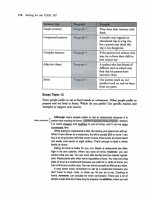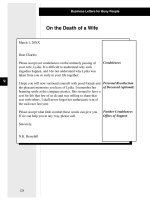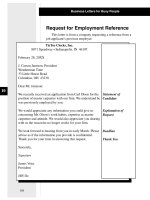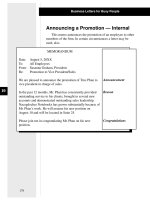Business Letters for Busy People part 25 pot
Bạn đang xem bản rút gọn của tài liệu. Xem và tải ngay bản đầy đủ của tài liệu tại đây (83.24 KB, 10 trang )
228
• Compliment to Employee for Work
• Etceteras: Smileys, Acronyms, Caps and “Flaming”
• Pros and Cons of E-mail Use
At the side of the page, you will find a brief explanation of
each part of the e-mail. The first letter identifies each section of
the message. Subsequent messages identify only changes to the
basic format.
Step-by-Step Guide
Within a business, e-mail is primarily used to communicate
internally, providing the user with the convenience of reaching
many people quickly and simultaneously. It can be used to send
notices to departments, update team members on a project or
inform employees of benefits information or training
opportunities. The e-mail letter can be printed by the recipient to
be used for documentation. While humor and informality can be
acceptable in this type of correspondence, the e-mail is strictly a
tool for quick communication.
Step 1: Most e-mail servers have boxes that look similar to
memo format. Complete the To and Subject boxes
first. The server’s software records the date and time
the message was sent.
Step 2: Make a plan, then be brief and tell it like it is. A lot of
e-mails that are sent off the cuff are followed by
second and even third messages, trying to correct or
update the information sent in the first. Take time to
plan the message, and then be sure to carefully review
it before hitting the send button!
This is one form of communication where the
recipient expects you to get right to the point. Make
your request or share your purpose in the first
sentence.
Step 3: Keep it plain and simple. The message format that one
person sends can often get scrambled in transmission,
creating annoying effects for the recipient. Keep the
format and the text simple to reduce the occurrence of
garbled messages.
Business Letters for Busy People
13
TEAMFLY
Team-Fly
®
13
Step 4: Sign off. Because e-mails come with a From box, the
recipient will know who has composed the message.
You may or may not want to add a complimentary
close and your name. Consider the recipient, the
context of the message and whether this courtesy is
applicable. Several options exist, including “Regards,”
“Thanks,” or simply your initials.
Note: It’s business!
Remember to be businesslike at all times. Write with
clarity and effectiveness, use standard English and
always be courteous!
Be careful when sending material that may be
sensitive or confidential. Think of e-mail as a postcard
— there is the potential for anyone to read it.
Messages can be intercepted or forwarded, whether
accidentally or intentionally, without your knowledge
or consent.
At the end of this chapter is a checklist to use when you write
an e-mail.
229
Electronic Mail
230
Announcement of Meeting
This e-mail is used by a supervisor to set up a series of
meetings and to announce the first scheduled meeting.
Business Letters for Busy People
13
To: Department Managers
From: C. Jarrett
Subject: Budget Meetings
We will be meeting to plan the capital budgets for the
coming year. I expect it will take three to four meetings for
us to get the numbers on the table and then work them all out
to the final projections.
The first meeting will be held on November 2 at 10 a.m. in
the conference room. We will set the remaining meeting
dates/times during this first one. Bring your department’s
budget projections and be prepared to explain how your
department will contribute to the company’s cost-cutting
drive.
Thanks,
Carl
Send/Receive/Subject
Information
Announcement
of Meeting
Confirmation of Date,
Time and Place
Information Requested
Complimentary Close
and “Signature”
Message Verification
Be sure to verify that your mail has been received,
especially those messages deemed a high priority. E-mail
networks, software and computers are not always reliable,
and messages sometimes go undelivered. In addition, you
are not likely to find out that the message was not delivered
unless you take the time to verify through the “return
receipt” box or another service that your e-mail software
provides.
13
Change in Client Status
Announcement
This message announces the change in status of a client and
explains an unusual situation and how it is to be handled.
231
Electronic Mail
When to Use E-mail
• To reach a lot of people quickly at the same time
• To send a short, personal message that doesn’t require
official letterhead and signature
• To send a message that does not need the security or
confidentiality of traditional mail
To: All Supervisory Personnel
From: D. Broadwik
Subject: TriState Industrial Services Account Status
Effective immediately: DO NOT SERVICE TriState
Industrial Services.
TIS has dropped their contract with us, as of the end of last
month. They are not entitled to any service. But evidently,
word has not gotten around to all of TIS’s personnel. We
continue to get calls from their people.
Please make sure all staff members are aware of this change.
This may be awkward, since many staff members have built
relationships with people at TriState, but we cannot service a
company that is no longer a client.
If anyone from TriState needs to discuss this, forward them
to me at ext. 920 or to Seta Alvarez at 923.
Thanks for your help with this situation.
Duane Broadwik
Description of
Status Change
Additional
Information
Contact Information
232
Request for Assistance
This e-mail is used to direct all staff to help locate a
missing file.
Business Letters for Busy People
13
To: Human Resource Department Staff
From: T. Mattieson
Subject: Missing File on Capital Bank of Camden
We are not able to locate the project file for Capital Bank of
Camden. If you have borrowed it, have found it or have any
idea where it may be, please call me ASAP at ext. 1310.
Thanks!
Terry
Request
13
Request for Materials Ordered
A direct e-mail can be a very effective way of making a quick,
informal request.
233
Electronic Mail
To: Roger Carlton
From: C. Celderon
Subject: Presentation Slides Not Delivered
Roger,
You were going to have the presentation slides for the
Cortland project to me by yesterday. They have not arrived.
Please get in touch with me ASAP! We’ll need those slides
for tomorrow afternoon’s presentation!
I left a voice mail with you this morning, too.
Charlie
Request
Additional
Information
Be Considerate
The more serious the message, the less appropriate the use
of e-mail for communication. Bad news of any kind should
never be sent via e-mail. Formal information can be
altered, forged or duplicated easily in an e-mail format.
Never send any communication that you would not be
willing to say to someone’s face. Always consider whether
the joke or witty memo is one you would share with your
boss before forwarding it on to someone else.
234
Project Offer
E-mail can be a quick way to informally offer a contract or
project to an employee or outside client. As with any job offer, be
sure to consider the e-mail message like a contract. Outline all of
the essential information the person will need to make the decision
to accept or reject the project.
Business Letters for Busy People
13
To: Patrick Murphy
From: R. Jordan
Subject: Book Revision Project
Pat,
I have a book revision project if you’re interested. The book
is Business Communication Made Easy. It was last revised
in 1993.
Revision points would include:
• Updating form sections
• Updating samples and language in samples
• Adding section on e-mail
• Adding any communication strategies for new or
changed situations
This would be work for hire. Turn around time is about two
months (text in by Nov. 29). Fee is $3,600.
If you’re interested, I’ll overnight the book to you so that
you can take a look at it. We need to have a contract on this
by midweek.
Thanks,
Rich
Offer
Background
Description of
Project Goals
Fee and Time Frame
13
Follow-Up on Project
E-mail is a convenient form of communication when sharing
information is the primary purpose. A telephone call might take
more time than is really necessary to simply share the information,
and a formal letter would take more effort and resources than
necessary.
The following is a message that describes the employee’s plan
of action and makes a request for input. The sender notes that an
attachment will come with the message, making certain the
receiver will look for it.
235
Electronic Mail
To: Rich Jordan
From: P. Murphy
Subject: Revision Outline
Rich:
I’m attaching the overall description of the plans I have for
revision of the BCME project. I will begin working directly
with the text that you sent me, but would like you to review
these plans for your input/direction.
I will be adding additional information about the use of
postcards to Chapter 3. And, I will work up a new chapter on
informal business meetings (i.e., the coffeehouse,
bookstore, etc.).
Unless something unforeseen should arise, I will expect this
project to be wrapping up by the end of next week. Hope that
will get it to your layout team with plenty of time to spare.
As always, your feedback is valuable and appreciated!
Murph
Notation of
Attachment
State Purpose and
Make Request
Additional
Information About
Plans
Time Frame
236
Compliment to Employee for Work
An e-mail can be a personal way to say thank you to someone
for their great work on a project or proposal. The sender also has
the option of forwarding copies of this acknowledgment to other
members of the department as public recognition of the person’s
work.
Business Letters for Busy People
13
To: R. Littleton
From: J. Griener
Subject: Thank you!
Ron:
Thank you for all the great work on the Masterson project!
As you know, this was a really big one for our group, and it
was thanks to you that the project got out the door on time.
I and everyone at MetroCom truly appreciate and applaud
your work!
Best regards,
Jane
Acknowledgment of
Work Well Done
Message of
Appreciation
Etcetera
Smileys, or emoticons, are keyboard characters formed to create faces that express
emotions. While some of the computer savvy find these expressions to be fun additions
to e-mail correspondence, many consider them to be just too cute for business. Limit
their use to recipients you’re sure won’t mind.
The use of acronyms and online abbreviations should be limited to familiar recipients,
as well. Not everyone will be aware that IOW means “in other words,” or that IMHO
stands for “in my humble opinion.”
Using ALL CAPITAL LETTERS is inappropriate for e-mail communication.
Messages in all caps are much harder to read and indicate that you are shouting your
message. Use capitals to STRESS certain words sparingly.
“Flaming” is an online term for messages that are highly emotional, angry or insulting.
Be sure to check the tone of your message and keep your emotions in check.
13
Checklist
• Did you complete the to/from/subject information?
• Did you make your request or share your purpose in the
first sentence or two?
• Did you keep the format and text plain and simple to
avoid a garbled transmission?
• Did you write with clarity, effectiveness and courtesy?
• Did you check the content of your message for sensitivity,
confidentiality and privacy issues?
• Did you include all the background information, project
details or request specifics so the recipient understands
your expectations?
237
Electronic Mail
E-Mail Pros and Cons
Pros Cons
Fast and easy delivery for “official” business Questionable appropriateness
Tone can be very personal Format often lost in recipient’s copy
Can reach many readers at one time Not completely secure and confidential
Users can print a clear hard copy No “real” original hard copy with signature
Reader can save message in a file Message must be very short
Easy for reader to reply Recipient must have a computer and e-mail software
Inexpensive
Can be forwarded to another reader Can be forwarded accidentally
Eliminates unnecessary paper
Allows off-site workers to collaborate on
projects easily









